
Manitoba Initiatives
Western Climate Initiative (WCI)For more information click here
Manitoba 2010 Climate Report - Shows Rising Emissions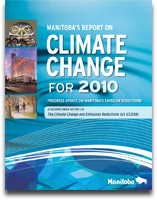 A Manitoba 2010 greenhouse gas (GHG) emissions report required by the Climate Change and Emissions Reduction Act is now available, announced Manitoba Conservation and Water Stewardship Minister Gord Mackintosh January 31, 2012.
A Manitoba 2010 greenhouse gas (GHG) emissions report required by the Climate Change and Emissions Reduction Act is now available, announced Manitoba Conservation and Water Stewardship Minister Gord Mackintosh January 31, 2012.The report shows Manitoba's carbon equivalent (C02e) GHG emissions have hovered around 20 mega tonnes (mt) since 2000. Emissions were lowest in 2001 at 19.7 C02e mt and highest in 2008 at 21.6 C02e mt. Overall emissions have declined 2% from 20.7 C02e mt in 2000 to 20.3 C02e mt in 2010. Much of this decline is due to the global economic recession and several plant closures in Manitoba. Emissions were 20.2 C02e mt in 2009, but began to creep back up in 2010. The Climate Change and Emissions Reduction Act had established an emissions reduction target of 6% below 1990 levels by 2012. But acting Conservation Minister Dave Chomiak admitted in December 2011 that Manitoba was unlikely to achieve this target. Manitoba's 2010 emissions are more than 12% above 1990 levels. Although the act was first passed in June 2008, several important provisions of the Climate Change and Emission Reduction Act will not come into force until October 2012. A December 2010 report by Manitoba's Auditor general heavily criticized the Manitoba government for failing to meet or accurately report on the status of its climate change initiatives, carbon inventory, or emissions reductions. The Auditor General specifically said that Manitoba's government needs to move to actual emissions data, and away from estimates and projections. Annual per capita emissions for Manitoba are 16.6 C02e tonnes (t), which is below the per Capita Canadian average of 20.5 C02e t, but higher than Quebec (10.4 C02e t), Ontario (12.6 C02e t), P.E.I (13.4 C02e t), and B.C (14.3 C02e t) according to the latest 2009 National GHG Inventory Report. View January 31, 2012 Government of Manitoba press releaseView January 2012 Manitoba's Report on Climate Change for 2010 (PDF) View January 31, 2012 Winnipeg Free Press coverage View December 29, 2011 CBC coverage View December 9, 2011 Manitoba Wildlands news item Source: Government of Manitoba
Recession Lowers Manitoba GHG Emissions Environment Canada's National Inventory Report shows Manitoba 2009 greenhouse-gas (GHG) emissions declined 6.3 per cent over 2008 emissions to 20.3 mega-tonnes (Mt). This was just slightly ahead of the national average drop in GHG emissions during 2009. The global recession and reduced use of coal are primarily responsible for the decline.
Environment Canada's National Inventory Report shows Manitoba 2009 greenhouse-gas (GHG) emissions declined 6.3 per cent over 2008 emissions to 20.3 mega-tonnes (Mt). This was just slightly ahead of the national average drop in GHG emissions during 2009. The global recession and reduced use of coal are primarily responsible for the decline.Nearly half the emissions reduction are due to three Manitoba large emitters:
In 2008, the Manitoba government legislated its Kyoto goal - a 6% reduction in emissions below 1990 levels must be met by December 31, 2012. Manitoba's 2009 emissions are still nearly 10% above 1990 levels. Manitoba Conservation Minister Bill Blaikie admitted it will be a challenge for Manitoba to meet its Kyoto target, stating: "We won't get there incrementally. We're likely going to need to make some significant changes. We're going to need some big ideas." GHG emissions data for Manitoba for other high emission sectors is still based on estimates and projections. View May 17, 2011 Environment Canada reportView May 17, 2011 Winnipeg Sun article View May 17, 2011 Manitoba Government News Release View May 17, 2011 Winnipeg Free Press article View United Nations Framwork Convention on Climate, National Inventory Submissions 2011 webpage Source: Winnipeg Sun, Environment Canada
Manitoba Will Not Meet Kyoto Target Says Auditor General Auditor General of Manitoba, Carol Bellringer, released her 2010 Report to the Legislative Assembly - Performance Audits including four audits, with an audit of the Manitoba Government performance managing climate change.
Auditor General of Manitoba, Carol Bellringer, released her 2010 Report to the Legislative Assembly - Performance Audits including four audits, with an audit of the Manitoba Government performance managing climate change.The audit shows Manitoba needs to update its current climate change plan, Beyond Kyoto, Manitoba's Green Future, Next Steps: 2008, as Manitoba will not meet it's Kyoto emission reduction targets of a 6% reduction in greenhouse gas (GHG) emissions from 1990 as required under the Kyoto Protocol. Even accepting Manitoba's GHG emission reduction projections for 2012 shows Manitoba emission will be 12% higher than in 1990. Manitoba's 2008 emissions were 17% above 1990 levels according to Environment Canada's National Inventory Report released April 2010. This is not the first time Manitoba's has failed to meet it's own GHG emission targets. In its 2002 Climate Change report, Kyoto and Beyond: Meeting and Exceeding Our Kyoto Targets, the government optimistically indicated, "we believe we can achieve reductions of up to 18 per cent below 1990 levels by 2010, and reductions of up to 23 per cent by 2012." The 2002 plan was removed from government websites, and the target downgraded to 6% below 1990 levels when the 2008 climate plan was released. Bellringer highlighted Manitoba's lack of emission targets beyond 2012, and lack of a government-wide tracking system for actual emission reductions, and climate change spending and related economic and social outcomes. (such as the number of jobs created, the non-Provincial funding leveraged, and the number of low-income housing units retro-fitted). In June 2008 Manitoba enacted the Climate Change and Emissions Reduction Act, which enshrined Manitoba's 6% emission reduction by 1990 target into law. The act does not provide any punishment provisions for failure to meet the target, but former Premier Gary Doer suggested: "If we don't achieve it, the ultimate penalty in 2011 will be defeating the government." View December 6, 2010 CBC News articleView December 6, 2010 Prince Edward Island Guardian article Listen December 6, 2010 CJOB 680AM story (audio) View December 7, 2010 Winnipeg Free Press article View Beyond Kyoto, Manitoba's Green Future, Next Steps: 2008 Action on Climate Change View Environment Canada National Inventory Report 1990-2008: Greenhouse Gas Sources and Sinks in Canada  Download December 6, 2010 Office of the Auditor general of Manitoba news release (PDF) Download December 6, 2010 Office of the Auditor general of Manitoba news release (PDF) Download Kyoto and Beyond: Meeting and Exceeding Our Kyoto Targets: 2002 (PDF) Download Kyoto and Beyond: Meeting and Exceeding Our Kyoto Targets: 2002 (PDF) Download December 2010 Office of the Auditor general of Manitoba report (PDF) Download December 2010 Office of the Auditor general of Manitoba report (PDF)Source: CBC News, Office of the Auditor General
Responses to Manitoba Cap and Trade Review The Pembina Institute submitted comments on Manitoba's proposed cap-and-trade system as required by the Western Climate Initiative (WCI).
The Pembina Institute submitted comments on Manitoba's proposed cap-and-trade system as required by the Western Climate Initiative (WCI).Cap-and-trade is a market-based way to cut greenhouse gases that uses economic incentives so that industrial polluters meet emissions reduction targets. Polluters get emission allowances equal to a government cap. If a plant's pollution exceeds the target or cap, it must purchase emission allowances from facilities that have reduced more than their share or else pay fines. The Pembina Institute suggested: Manitoba move quickly to implement a cap-and-trade system by January 2012, set a cap that aligns with short- and medium-term emissions reduction targets, include all source of measurable emissions, and distribute allowances by auction, and eliminate or reduce any reliance on offsets. Canadian Parks and Wilderness Society (CPAWS) Manitoba Chapter submitted comments that echo Pembina Institutes concerns, warning about the short-comings of relying on offsets, and arguing that revenue from a carbon pricing scheme should be used to fund GHG reductions, such as investing in carbon storage through ecosystem protection. The Manitoba Government set up a webpage to collect comments on the proposed Cap and Trade system; however the comments are not being made publicly available on the Government webpage. There is also no public registry for the review. View March 15, 2011 Pembina Institute "Recommendations for Manitoba's proposed cap-and-trade system"View March 16, 2011 CPAWS Manitoba Chapter "Recommendations for Manitoba's proposed cap-and-trade system" View Manitoba Government "Cap and Trade Consultation" webpage View December 4, 2011 Manitoba Wildlands news item Source: Pembina Institute
Cap and Trade "Consultation" for Manitobans The Manitoba government has launched a website to gather input on proposed cap-and-trade regulations aimed at reducing harmful emissions from polluting industries. Comments are due by March 15, 2011.
The Manitoba government has launched a website to gather input on proposed cap-and-trade regulations aimed at reducing harmful emissions from polluting industries. Comments are due by March 15, 2011.Climate Action Network Canada board member Gaile Whelan-Enns noted the consultation were inadequate, "it appears there's no public meetings, no presentations, nor is there a public registry." Cap-and-trade analyst Matt Horne of the Pembina Institute agreed that thorough consultation on the topic is vital, "there's a bunch of nuts and bolt issues that really do matter. The devil is in the details." Cap-and-trade is a market-based approach to cutting greenhouse gases that uses economic incentives to force industrial polluters to meet an overall emissions reduction target. Polluters get emission allowances equal to government pollution cap. If a plant's pollution exceeds the target or cap, it must purchase emission allowances from facilities that have reduced more than their share or pay fines. Manitoba's system would integrate with the Western Climate Initiative (WCI), a regional cap-and-trade program. Current WCI members include B.C., Manitoba, Ontario, Quebec, California and six other western U.S. states. No government press release has been issued. View Manitoba Government webpage "Cap and Trade Consultation"View November 17, 2010 CBC News article View Western Climate Initiative website  Download Manitoba Government Proposed Cap and Trade System: Backgrounder (PDF) Download Manitoba Government Proposed Cap and Trade System: Backgrounder (PDF)Source: CBC
Brandon to Reduce Landfill Greenhouse Gases The Manitoba Government and City of Brandon plan to reduce greenhouse-gas emissions from the Eastview Landfill through a $1.275-million agreement as part of Manitoba's landfill gas capture program. The Manitoba Government and City of Brandon plan to reduce greenhouse-gas emissions from the Eastview Landfill through a $1.275-million agreement as part of Manitoba's landfill gas capture program.Up to $1.275 million will flow to Brandon to design and construct a facility to capture methane gas generated at the landfill. The Brandon project will eliminate an estimated 57,000 tonnes of greenhouse-gas emissions each year, the equivalent of taking 11,000 cars off the road. "The City of Brandon is pleased to work with the Province of Manitoba on this extremely important environmental initiative," said Dave Burgess, Mayor of Brandon. "This agreement will lead to elimination of thousands of tonnes of greenhouse gas, improving the environment in Brandon and contributing to the overall reduction of greenhouse gas in this province," stated Conservation Minister Bill Blaikie. Manitoba's landfill gas capture program will enable three of the province's largest landfills to make significant reductions to the amount of greenhouse gas emissions they release. In total, this will amount to 195,000 tonnes of reductions per year, or almost one per cent of the total Manitoba emissions. View July 8, 2010 Government of Manitoba news releaseView July 8, 2010 Winnipeg Free Press article View July 8, 2010 Brandon Sun article Source: Manitoba Government
Manitoba Launches Green Registry The Government of Manitoba launched GreenRegistry.org October 30, 2008. The Green Registry is a website that provides organizations, companies, families and individuals with information, guidance, and tools to help Manitobans "understand the sources of greenhouse gas (GHG) emissions and how to measure and reduce these emissions".
The Government of Manitoba launched GreenRegistry.org October 30, 2008. The Green Registry is a website that provides organizations, companies, families and individuals with information, guidance, and tools to help Manitobans "understand the sources of greenhouse gas (GHG) emissions and how to measure and reduce these emissions". View October 30, 2008 Government of Manitoba press release Visit Manitoba's Green Registry There are four main sections to the Green Registry:
Manitoba's commitment to the Kyoto target of reducing greenhouse gas (GHG) emissions 6% below 1990 levels by 2012 is also clearly indicated. The website provides aggregate 1990 GHG emissions baseline for Manitoba of 18Mt and acknowledges that by 2005 the province's GHG emissions had risen by 12.8% to 20.3Mt. The Green Registry does not provide new or more detailed information about Manitoba's GHG on a sectoral basis (GHG emissions breakdown for the transportation, agriculture, energy, residential, heavy industry sectors or emissions from major development projects or public works projects). The Green Registry website does not include a carbon or GHG inventory for the province. It appears Manitoba's actual 'Green Registry' (still in development) will be used to register, track and showcase verified GHG emissions reductions and removals (VERRs). It appear the Green Registry will not be used as a tool for reporting of GHG emissions generated by Manitobans, Manitoba companies and the Manitoba government. No baseline data, thresholds, or GHG/carbon inventories are provided. Manitoba Wildlands will be watching to see how this registry and future regulation will fulfill the climate change protocols our government has signed onto with US partners. Source: Government of Manitoba
Manitoba's Rank Slips - Analysis of Climate Plans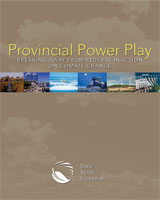 Last year in its analysis and ranking of provincial and territorial climate change plan, the David Suzuki Foundation (DSF) praised Manitoba for having the second-best plan in Canada (released in 2002), second only to Quebec.
Last year in its analysis and ranking of provincial and territorial climate change plan, the David Suzuki Foundation (DSF) praised Manitoba for having the second-best plan in Canada (released in 2002), second only to Quebec.View Manitoba Wildlands' content on DSF's previous analysis and ranking of climate change plans This year, Manitoba's ranking slipped; its plan is now rated as 'good', along with Ontario's plan, while Quebec's plan is rated as 'very good' and British Columbia tops the list with a rating of 'best'. Manitoba released a new climate change plan in April 2008. View April 21, 2008 Government of Manitoba press releaseView Manitoba's 2008 climate change plan, Beyond Kyoto: Manitoba's Green Future The David Suzuki Foundation (DSF) report, Provincial Power Play: Breaking Away from Federal Inaction on Climate Change, looks at provincial and territorial action on climate change, compares their greenhouse gas emissions, assesses their climate change plans and evaluates their records. Manitoba Wildlands contributed information and analysis for evaluation of Manitoba's climate change plan. The report was released July 16, 2008 at the Council of the Federation meeting in Quebec City, where provincial and territorial premiers met to discuss what they can do on climate change. View July 16, 2008 David Suzuki Foundation press release Download July 2008 David Suzuki Foundation report, Provincial Power Play: Breaking Away From Federal Inaction on Climate Change (PDF) Download July 2008 David Suzuki Foundation report, Provincial Power Play: Breaking Away From Federal Inaction on Climate Change (PDF)Manitoba was applauded for:
The report, however, also found that Manitoba could still strengthen and improve its climate change plan and initiatives. The province does not yet have a policy or program in place to protect natural carbon stores in forests and peatlands, is lacking in meaningful policies to address emissions from the transportation sector, and needs to have a formal plan to adapt to climate change impacts. The Manitoba government has ignored its responsibility to report to Manitobans on specific results and actions since the 2002 Climate Change Plan, Kyoto and Beyond. Federal Climate Plan Weak - Provinces and Territories Lead The federal approach to making polluters pay for carbon emissions will take four years to develop and will be a weak and already discredited intensity-based system. So far, only governments that clearly oppose action on climate change have used intensity targets (GHG emission reductions per unit of economic activity, like a barrel of oil produced), and their emissions have continued to rise. As a result, the Suzuki Foundation is calling on the federal government to follow the lead of the provinces and set strong, national standards across Canada (in order to create a level and fair playing field). This is especially important in order to rein in greenhouse gas increases in Alberta. The report warns it will be impossible for Canada to meet international standards if Alberta doesn't do something substantive on global warming. "Nothing calls out for concerted federal government action on climate change more than Alberta's callous indifference to its impacts on the planet," says the report. View July 16, 2008 Globe and Mail articleView July 16, 2008 Canwest News Service article View July 16, 2008 Calgary Herald article Sources: David Suzuki Foundation, Globe and Mail, CanWest News
Passage of Bill 15 - Manitoba Climate Change Legislation On June 12, 2008, Manitoba's Climate Change and Emissions Reduction Act (Bill 15) received royal assent in the Manitoba legislature, enshrining Manitoba's commitment to meeting the Kyoto protocol target by 2012 for reduction of greenhouse gas (GHG) emissions and the commitment to set long term emissions reduction targets in law.
On June 12, 2008, Manitoba's Climate Change and Emissions Reduction Act (Bill 15) received royal assent in the Manitoba legislature, enshrining Manitoba's commitment to meeting the Kyoto protocol target by 2012 for reduction of greenhouse gas (GHG) emissions and the commitment to set long term emissions reduction targets in law.View June 12, 2008 Government of Manitoba press release View Manitoba's Climate Change and Emissions Reduction Act Certain sections of the Act have not yet been enacted and will come into force later by proclamation. As of August 2010 sections 7, 8, 11, 12, & 21 had still not been proclaimed. These sections provided for: green building requirements for government owned or funded buildings (s. 7 & 8), fuel efficiency standards and alternative fuel requirements for government vehicles (s. 11 & 12), and, subject to certain exemptions, an end to the importation of motor vehicles made in 1995 or before (s. 21). View proclamation status of the Climate Change and Emissions Reduction ActMore than two years after passage, only two regulations have been drafted under the Climate Change and Emissions Reduction Act. Regualtion 180/2009 defines "prescribed landfills" as being those containing more than 750,000 tonnes of waste. In combination with s. 15 of the Act, this regulation requires the province's three largest landfills to capture or flare excess methane. Regualtion 186/2009 sets out procedures for notification, and defines when Manitoba Hydro may burn coal for the purposes of emergency operations. View regulations under the Climate Change and Emissions Reduction ActThe legislative process for Bill 15 included an opportunity for the public to speak and/or submit comments as part of a session of the all party Legislative Review Committee of the Manitoba legislature. Gaile Whelan Enns, Director of Manitoba Wildlands, appeared before the committee to support the Bill, and recommend steps to strengthen the Bill.  Download May 26, 2008 comments by Gaile Whelan Enns at the Manitoba Standing Committee Hearing Download May 26, 2008 comments by Gaile Whelan Enns at the Manitoba Standing Committee Hearing  (DOC) (DOC)Source: Government of Manitoba
Manitoba Introduces Climate Change Legislation On April 11, 2008, Manitoba introduced new legislation - Bill 15 The Climate Change and Emission Reductions Act - that requires the province to meet Canada's Kyoto target for 2008-2012 and set long-term goals for 2020 and 2025.
On April 11, 2008, Manitoba introduced new legislation - Bill 15 The Climate Change and Emission Reductions Act - that requires the province to meet Canada's Kyoto target for 2008-2012 and set long-term goals for 2020 and 2025.In order to meet its Kyoto commitments, Manitoba must reduce its annual emissions to 17 megatonnes (MT) from approximately 20 MT. To achieve this, the first goal is to reduce GHGs below 2000 levels by 2010. To meet its 2012 target, Manitoba is proposing to annually:
The Climate Action Network (CAN-RAC), Canada's umbrella organization representing environmental and civil society from across the country who are concerned about global climate change, congratulated Manitoba for taking a leading role in the fight against climate change in Canada. There are questions and concerns because the legislation leaves many questions that will only be answered as regulations are drafted and come into force - which will take some time. Gaile Whelan Enns, Director of Manitoba Wildlands, emphasized the need for Manitobans to support the legislation and get involved in building the substance of the legislation, as it currently provides only a basic framework. "Our government is acting on its commitments to reduce emissions inside Manitoba by meeting the Kyoto target. Cooperative work with large emitters, and collaboration with Manitoban communities and companies, will provide models for other provinces and states." Recommendations for the transportation regulations will not be made until 2009, which means that they may not come into effect until 2010 - a significant time gap that could be avoided if Manitoba simply follows California's lead.  Download April 11, 2008 Transcript of Bill 15 press conference with Premier Doer Download April 11, 2008 Transcript of Bill 15 press conference with Premier Doer  (PDF) (PDF)View April 11, 2008 Manitoba Government press release  Download April 11, 2008 Manitoba Government Backgrounder (DOC) Download April 11, 2008 Manitoba Government Backgrounder (DOC)View Manitoba Government Bill 15, Climate Change and Emissions Reductions Act View April 11, 2008 Climate Action Network Canada press release Sources: Government of Manitoba, Climate Action Network Canada
Audit - Manitoba Climate ChangeManitoba Wildlands is auditing the Manitoba government's climate change targets, actions and commitments.View the Audit - Manitoba Climate Change  Manitoba Signs Midwest Climate Accord/
|
Manitoba Initiatives Archives (Before 2005)
 2002-2014
2002-2014


 The governors of Iowa, Illinois, Kansas, Michigan, Minnesota, and Wisconsin and the premier of Manitoba signed the "Greenhouse Gas Accord", which commits the states and Manitoba to work together to slash emissions linked to global warming over coming decades. They will establish regional targets for reducing greenhouse gases as well as a regional cap and trade mechanism for carbon emissions.
The governors of Iowa, Illinois, Kansas, Michigan, Minnesota, and Wisconsin and the premier of Manitoba signed the "Greenhouse Gas Accord", which commits the states and Manitoba to work together to slash emissions linked to global warming over coming decades. They will establish regional targets for reducing greenhouse gases as well as a regional cap and trade mechanism for carbon emissions.  Manitoba Premier Gary Doer and British Columbia Premier Gordon Campbell signed a Memorandum of Understanding (MOU) October 23, 2007 that commits the two provinces to work together on a number of initiatives including climate change. Both provinces have also signed on as members of the Western Climate Initiative (
Manitoba Premier Gary Doer and British Columbia Premier Gordon Campbell signed a Memorandum of Understanding (MOU) October 23, 2007 that commits the two provinces to work together on a number of initiatives including climate change. Both provinces have also signed on as members of the Western Climate Initiative (
 Manitoba Premier Gary Doer joined the rest of Canada's Premiers and territorial leaders for the annual meeting of the Council of the Federation - the name given to itself by the group comprised of Canada's provincial and territorial leaders.
Manitoba Premier Gary Doer joined the rest of Canada's Premiers and territorial leaders for the annual meeting of the Council of the Federation - the name given to itself by the group comprised of Canada's provincial and territorial leaders.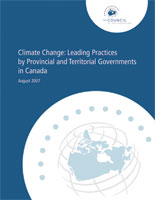 The August 10th Council of the Federation press release was less than earth shattering. A nation-wide climate change plan with binding emissions reduction targets was absent from the statement, and there is no mention of a carbon credit trading system.
The August 10th Council of the Federation press release was less than earth shattering. A nation-wide climate change plan with binding emissions reduction targets was absent from the statement, and there is no mention of a carbon credit trading system.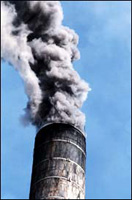 The Government of Manitoba will collaborate with the Canadian Standards Association (CSA) and Canadian Climate Exchange (CCE) in designing market based solutions to reduce greenhouse gas (GHG) emissions in Manitoba and beyond its borders. Market mechanisms are intended to provide a price signal and financial incentive for emissions reductions and the three parties will work together to help proponents develop and showcase GHG emission reducing projects.
The Government of Manitoba will collaborate with the Canadian Standards Association (CSA) and Canadian Climate Exchange (CCE) in designing market based solutions to reduce greenhouse gas (GHG) emissions in Manitoba and beyond its borders. Market mechanisms are intended to provide a price signal and financial incentive for emissions reductions and the three parties will work together to help proponents develop and showcase GHG emission reducing projects. There have been no updates to the Commercial Building Energy Code since 2006, however the Manitoba Government implemented the "Green Building Policy for Manitoba Government Funded Projects" to encourage green building, and Manitoba Hydro has implemented "PowerSmart Design Standards for New or Renovated Buildings" that must be followed to qualify for the Power Smart designation.
There have been no updates to the Commercial Building Energy Code since 2006, however the Manitoba Government implemented the "Green Building Policy for Manitoba Government Funded Projects" to encourage green building, and Manitoba Hydro has implemented "PowerSmart Design Standards for New or Renovated Buildings" that must be followed to qualify for the Power Smart designation.
 The second edition of The Suzuki Foundation's All Over the Map report assessed provincial and territorial action on climate change, compares each region's greenhouse gas emissions, analyzes their climate change plans and evaluates their records.
The second edition of The Suzuki Foundation's All Over the Map report assessed provincial and territorial action on climate change, compares each region's greenhouse gas emissions, analyzes their climate change plans and evaluates their records. 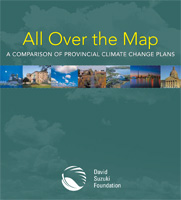 In The Suzuki Foundation's 2005 analysis, Manitoba's climate change plan was praised as the best of all the provincial and territorial plans. However, the report also noted that almost half of Manitoba's emission reductions are premised on hydro power export to US and points out that "Manitoba's greenhouse gas emissions increased 11.5% between 1990 and 2003". The report is also critical of a major weakness of Manitoba's climate change plan: a dependence on other governments to achieve its targets.
In The Suzuki Foundation's 2005 analysis, Manitoba's climate change plan was praised as the best of all the provincial and territorial plans. However, the report also noted that almost half of Manitoba's emission reductions are premised on hydro power export to US and points out that "Manitoba's greenhouse gas emissions increased 11.5% between 1990 and 2003". The report is also critical of a major weakness of Manitoba's climate change plan: a dependence on other governments to achieve its targets. Elizabeth May, former Executive Director of the Sierra Club of Canada, embarked on a cross-country tour in spring 2006 to raise Canadians' awareness about climate change. The tour, Clearing the Air on Climate Change, made a stop in Winnipeg on June 20, 2006. The speaking event was hosted by Manitoba Wildlands
Elizabeth May, former Executive Director of the Sierra Club of Canada, embarked on a cross-country tour in spring 2006 to raise Canadians' awareness about climate change. The tour, Clearing the Air on Climate Change, made a stop in Winnipeg on June 20, 2006. The speaking event was hosted by Manitoba Wildlands Also during December 2005, Manitoba and Premier Doer were featured by The Climate Group in their climate change awards. The Manitoba government is a founding member of The Climate Group.
Also during December 2005, Manitoba and Premier Doer were featured by The Climate Group in their climate change awards. The Manitoba government is a founding member of The Climate Group.